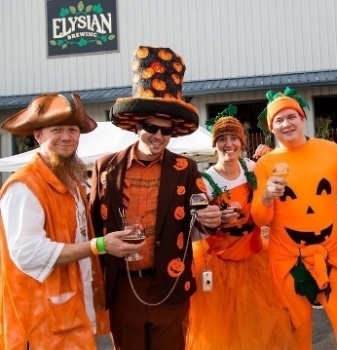Mega-pregnant and massively irritated by last summer’s sweltering weather, my wife made a serious demand. “We need to get out of Brooklyn,” she said, her face mere millimeters from our third-floor apartment’s sole air conditioner.
Outside, the city was broiling beneath a grueling heat wave. To my exceedingly expectant wife, it was as if hell had swallowed Brooklyn whole. “We’re going to New Hampshire,” she said. “Start packing.”
Lickety-split, we steered north to friends, family and cooler weather. Upon arrival, I required beer. Lots of them. In rapid succession. I headed to a convenience store, salivating at the prospect of aromatic Allagash White, crisp Smuttynose Vunderbar or Rising Tide’s bright Daymark pale ale. Heck, perhaps I’d buy them all! In-laws and a pregnant wife can give a man a deadly thirst.
 Great Pumpkin Festival at Elysian Brewing
Great Pumpkin Festival at Elysian Brewing
Inside the shop, my field of vision filled with orange. As far the eyes could see, there was a sea of Shipyard Pumpkinhead, the Portland brewery’s wheat ale spiced with cinnamon and nutmeg. Ignoring them, I grabbed a couple four-packs of Allagash White and a 12-pack of Sierra Nevada’s Summerfest.
“Sure you don’t want some Pumpkinhead?” the cashier asked, ringing me up.